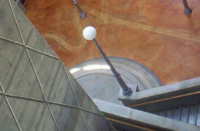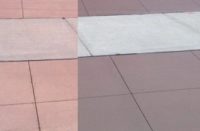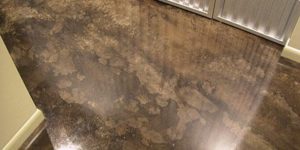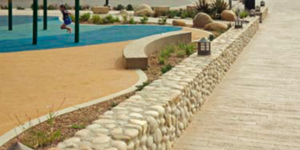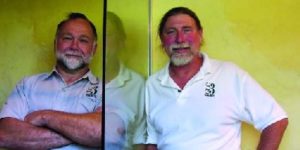Mike Riggs is a guy who can say that he really did grow up in the concrete business. His first job was for Progressive Concrete Works, a concrete company his father started in 1954 in Phoenix, Arizona. Riggs, now 54, went through a concrete apprenticeship program and became a concrete finisher. He progressed into estimating and management and in 1995 became head of the company.
He kept that business going 15 years, doing work throughout the state of Arizona. In 2010, he closed Progressive Concrete Works and started Progressive Hardscapes with Vince Van Heukelem, owner of Colorado Hardscapes. Progressive is the Arizona division of Colorado Hardscapes, and the two companies share a passion for decorative concrete and install many of the same finishes. By collaborating, they knew they could learn from each other and grow successfully as partners. With similar business models and pursuit for innovative decorative concrete finishes, the Colorado Hardscapes and Progressive Hardscapes partnership was a natural fit.

“The transition went smoothly and we kept all the same people that I had working for me and rolled everything over into the new company,” Riggs says. “We were very similar companies, except that Colorado Hardscapes was a larger organization than we were. It was a good move and I enjoy working as the general manager for the Arizona division.”
Riggs has always appreciated and enjoyed the challenges involved with doing concrete work at a high level. “A lot of what I do to keep myself engaged is keeping informed and getting involved in new products,” he says. “That and continuously learning. There’s always something to be learned in this industry and if you think you know it all you’re in trouble!”
Venturing beyond the basics
Back in the early 1970s, Riggs’ father became a licensee for Bomanite, installing the first imprinted concrete in Arizona, which allowed Progressive Concrete Works to rapidly expand their repertoire. “By the time I got involved we were doing both architectural concrete and standard foundations, floor slabs, residential and commercial… we were doing everything,” Riggs says. “The business slowly started carving a niche for itself in the architectural concrete sector.”
In the 1980s, Riggs began offering acid staining and countertops. “We’re always looking for new things,” he says. “Today we are doing a lot more contemporary finishes with exposed aggregate and sand finishes that we call Actacrete. We are also doing a lot of architectural concrete walls.”
Progressive Hardscapes is a Lithocrete and Lithomosaic licensee as well. “Lithocrete and Lithomosaics are a lot of fun,” he says. “You talk about artistry . . . it’s really cool to be able to have an opportunity to work directly with the artist on some of these types of projects and figure out how to bring their vision to life and actually achieve it.”
Seeing the potential of pervious
Nine years ago Riggs entered the pervious concrete market at a time when there was hardly any pervious being offered in Arizona. He chases down that market, and actively goes out and gives box lunch presentations to architects to inform them about what pervious is and what it can do.
In a niche market, he says, “You’ve got to get out and promote your products. You’ve got to educate architects and let them know what’s available.” He estimates there is about 550,000 square feet of pervious installed throughout the state, “And we’ve done the majority of the work.”
Riggs has made a career out of entering and developing niche markets, and the pervious market is no exception. “It takes a little different mentality,” Riggs says. “The placement procedures and related things are a lot different than standard concrete, so we’ve developed a crew of guys that pay particular attention to the details. This comes from working with architectural concrete. I am very fortunate that we have such a good group of people working for us. It’s a team effort and the men in the field do a great job!”
Progressive’s projects have set the bar high for pervious concrete in Arizona. In order to separate themselves from other pervious concrete contractors whose work may not meet their standards, Progressive branded its pervious concrete as DrainScape. “This name has come to be known as the premier pervious concrete,” Riggs says. “When owners and architects specify DrainScape they can be confident that they will have a quality installation installed by a highly skilled crew.”
In addition, Riggs offers Lithocrete Sedimentary Walls, board-formed walls and other work that might involve standard finishes but are difficult for some other reason. Those are also the jobs he likes best. “When things start getting a little more complex, those are the types of projects we really excel in,” he says. “The thing I really enjoy the most is the creative architectural projects where you have to think outside the box. It’s fun, it’s challenging, it’s just different.” He also has a penchant for anything pervious.
Riggs says the pervious work is “hit or miss” and the jobs are scattered, but the technique has great potential for alleviating some environmental concerns, so he’s hoping it continues to grow in popularity. He’s done jobs as large as 140,000 square feet and 110,000 square feet on park-and-ride stations. Currently, his crew is working on a 5,000-square-foot job at a hospital.
Pervious concrete allows groundwater to recharge, which has been a big benefit in these recent years of extreme drought in the West. “Pervious slows the rain water down and allows it to filtrate into the soil a little bit better,” Riggs says. He points to research conducted in collaboration with Arizona State University on a plot of pervious he poured. The study focused on the “heat island effect,” or how much heat a surface reflects into the surroundings and how quickly the surface cools.
During the day, the temperatures of the pervious plot were the same as regular concrete but at night it cooled off much faster, Riggs says. “The thermal mass in the regular concrete retains a lot more of that heat and that’s how pervious helps because it cools off a lot more at night. It’s a neat product and it allows developers to get more environmental benefit out of their projects and control pollution runoff. It also allows developers to increase the size of their buildings because they’ve been able to increase the size of their parking lots by reducing the size of retention basins. So the land can be used more effectively.”
|
|
Bringing ideas to life
One Lithomosaic project Riggs enjoyed working on involved a Tucson streetcar station where he helped an artist named Mary Lucking install full-color Lithomosaic cactuses and flowers along the stop’s entire platform. “It wasn’t big but it was fun,” he says.
Progressive Hardscapes is the licensed installer of the Sedimentary Wall system in Arizona. Sedimentary Walls, a product of the Lithocrete family, provide aesthetic interest and structural integrity. They are often used as seating walls or barriers where a natural look is warranted.
The walls are created by pouring layers of integrally colored concrete, often all in one color, with different types of seeded aggregate or glass placed to achieve the look of sediment building up over time. Riggs often pours the walls and then pressure washes them to create different levels of aggregate exposure.
Progressive Hardscapes has 15 to 20 employees at any given time, and one of the biggest things Riggs enjoys about the work is having the opportunity to work with other creative people to bring projects to life. “We get to take their ideas for what they want to do and turn it in something that’s constructible,” he says. “This has been my life and I really enjoy it too. What makes it fun is that you’re learning every day.”
www.drainscape.com
www.progressivehardscapes.com
